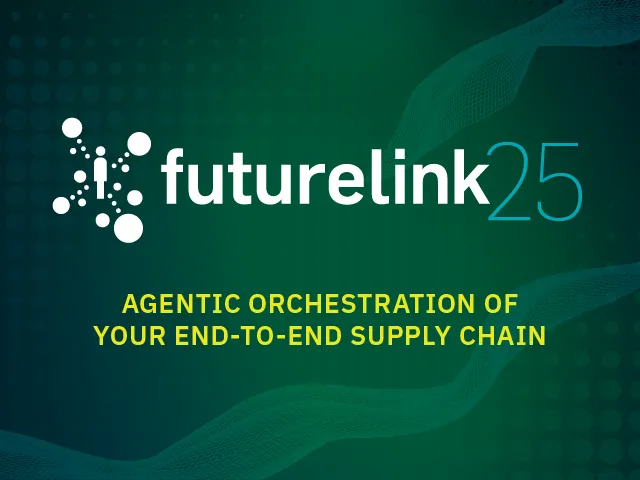Table of contents
"The agentic future is already upon us—it’s real, it’s momentous, and it’s transforming how we live and work together." In his keynote at FutureLink Barcelona 2025, TraceLink President and CEO Shabbir Dahod explained that success in this new era begins with one critical truth: artificial intelligence in the supply chain is impossible without real-time, end-to-end information that spans every partner and process.
Dahod described a future where intelligent agents will act as digital teammates—working for people, not replacing them—within the hierarchy of an organization. These agents will take on defined roles and responsibilities, reasoning over real-time information to support human decision-making and accelerate outcomes.
Agentic orchestration—the ability for intelligent agents to reason, collaborate, and act across an end-to-end network—can only exist on a foundation of accurate, contextualized, and shared data. Life sciences companies and their upstream and downstream supply chain partners have already laid much of that foundation. Through a decade of compliance and serialization investments on TraceLink, they’ve created an industry-wide data network unmatched in any other industry or sector. Now, Dahod said, it’s time to use that foundation—not just for compliance, but to orchestrate business outcomes and high-quality products for patients and their families.
Here are 10 key takeaways from Dahod’s keynote address that illustrate how life sciences can move from digitalization to intelligent, agentic orchestration.
1. Real-Time, End-to-End Data Is the Foundation of Agentic Orchestration
Intelligence—human or artificial—depends on the quality of information fed into it. “There is no agentic, there is no Al—there is nothing—without information,” Dahod said.
Agentic systems and agents that rely on fragmented or outdated data, he warned, are doomed to produce hallucinations, errors, and misdirected actions. True agentic systems require real-time, end-to-end visibility—data that is accurate, complete, and continuously refreshed across every partner and process in the supply chain.
That foundation already exists in TraceLink’s Orchestration Platform for Universal Solutions (OPUS), which captures every transaction and exception in its operational context through metadata attached to each object and action. When agents reason over that data, they’ll be drawing on a single, reliable source of truth that reflects real supply chain operations—not partial or outdated views.
2. Context and Relationships Turn Data Into Intelligence
Having complete, real-time data is only the beginning. What makes that data valuable is how it’s connected. Dahod explained that intelligence emerges only when information is organized into relationships—when every purchase order, product, partner, and event can be understood in context.
That relational understanding is the bridge between information and agentic reasoning. When data carries context, intelligent systems can interpret not just what happened, but why—and what should happen next. Companies that establish this contextual foundation today will be the ones ready to reason, predict, and act intelligently tomorrow.
3. Compliance Has Laid the Groundwork for Agentic Orchestration
More than a decade of serialization and traceability initiatives has created a shared digital foundation across the life sciences supply chain. Each compliance milestone—driven by the need for visibility, verification, and patient safety—has strengthened the flow of reliable data linking manufacturers, distributors, logistics providers, and pharmacies. Together, those efforts have built a living network that now links tens of billions of serialized products and transactions through on TraceLink.
That foundation gives the industry both an opportunity and a responsibility. “Our purpose is pharmaceuticals that save lives,” Dahod said. “We have a purpose greater than anybody else to leverage this foundation to drive the future.”
4. Make Digitalization Universal, Not Exclusive
Technology should not create hierarchies between the digital “haves” and “have-nots.” TraceLink’s vision is an inclusive digital ecosystem where every company, regardless of size or technical maturity, can operate on equal footing.
That’s the logic behind TraceLink’s Integrate-Once™ model—a framework that allows every organization to exchange data and collaborate securely without costly custom integrations, simply by leveraging their own preferred method of integration and information exchange. “You come as you are, you work as you want, and we’ll make you all work together,” Dahod said.
By removing the friction of complex IT projects, the Integrate-Once™ approach ensures that the entire industry—not just its largest players—can participate in and benefit from agentic orchestration.
5. Build on a Compliant, Scalable, and Trusted Infrastructure
Before intelligent systems can act autonomously, their environment must be resilient, auditable, and compliant. Dahod reminded the audience that TraceLink OPUS was built to meet that standard from day one.
It runs across multiple global data centers, performs annual disaster recovery tests, and maintains a GMP-compliant, fully auditable architecture. That industrial-grade foundation ensures that agentic operations can function with the same level of reliability the pharmaceutical industry demands of its own products.
Agentic orchestration isn’t about experimentation—it’s about operational trust. And that trust begins with infrastructure.
6. Transform Supply Chain Transactions Into Shared Intelligence
Every transaction in the supply chain—every purchase order, shipment, and acknowledgment—represents an opportunity to generate intelligence. When those transactions are captured digitally and shared in real time across partners, they become a continuous source of operational insight rather than isolated records.
Through TraceLink solutions such as Multienterprise Information Network Tower (MINT) and OPUS Reports and Dashboards, that insight comes to life. Organizations can see emerging trends in orders and inventory, anticipate shortages, and coordinate responses before disruptions occur. Instead of reacting to problems, they can act with the same data and context across the entire network.
MINT provides the real-time integration layer that links data across multiple partners and systems, while OPUS Reports & Dashboards turns that data into a shared, visual understanding of performance. Together, they enable every stakeholder to reason, decide, and act on the same trusted information—creating the shared intelligence and coordination needed for agentic orchestration to emerge.
7. Replace Fragmented Communication with Structured Collaboration
Manual coordination across enterprises—through emails, spreadsheets, and phone calls—has long been one of the biggest drains on productivity. TraceLink Process Orchestration for Empowered Teams (POET) changes that dynamic by digitalizing the teamwork itself.
Dahod described POET as a “palette” that lets business users design their own collaborative processes, from change control to batch record review to exception management. Each process becomes a structured, traceable workflow that all permissioned parties involved can see and act on.
By transforming human collaboration into structured, digital workflows, POET does more than improve efficiency—it creates the contextual data that future agents will reason over. Every interaction, approval, and exception becomes part of the shared intelligence that will ultimately enable agentic orchestration.
8. Create a Shared Understanding for Faster, Smarter Decisions
When partners need to make time-sensitive, data-driven decisions—like reconciling orders, resolving shipment discrepancies, or aligning on inventory—working from the same current facts accelerates alignment and reduces rework. Reports & Dashboards on OPUS makes that possible by giving each organization real-time analytics that are filtered for its own data yet anchored to a single, trusted view.
At FutureLink, Dahod demonstrated how a manufacturer and its CMO could view identical dashboards, drill into the same metrics, and resolve discrepancies instantly—no spreadsheets, no email threads.
That level of alignment builds trust and turns data into a common language for decision-making. It’s also the clarity that future intelligent agents will rely on to reason, coordinate, and recommend the next best action.
9. Replace General AI Ambition with Artificial Expert Intelligence
Dahod distinguished TraceLink’s approach to AI from the industry’s race toward general-purpose intelligence. The company is building what he called artificial expert intelligence—small, specialized agents designed to reason within the strict context of life sciences operations that run on small language models (SLMs).
By embedding “meta reasoning” into OPUS, these agents understand the purpose and relationships behind every object in the system: what a purchase order is, why an exception exists, which partner it concerns, and how each action affects the business.
Every agent has a defined role, permissions, and audit trail. Humans remain the managers, reviewers, and decision-makers. The result is intelligence that acts with understanding—not automation that acts in isolation.
10. Prepare for the Next Phase of Agentic Orchestration
Agentic orchestration is already taking shape, and its impact will accelerate as new technologies expand how systems learn, reason, and collaborate. The next step for every organization is to continue strengthening its digital foundation—turning today’s information into the intelligence that will power tomorrow’s supply chains.
TraceLink is advancing that journey with innovations that will make agentic orchestration more scalable and dynamic. Tempo, TraceLink's upcoming no-code/low-code framework that empowers companies to build new business intelligence solutions, will enable companies to build analytics databases that continuously learn from operational data in real time. Model Context Protocol (MCP) will provide a standardized way for agents to exchange information securely across different systems and networks. TraceLink will leverage MCP to ensure that agentic capabilities extend safely beyond the boundaries of a single platform—linking partners, data, and decisions across the end-to-end supply chain.
As Dahod reminded the audience, the opportunity is already here. “It’s mind-blowing what we can do,” he said. “And we’re just beginning.” The organizations that keep moving forward—digitalizing their transactions, processes, and collaboration—will define how agentic orchestration transforms the industry in the years ahead.
Ready to learn more? Watch the full FutureLink Barcelona keynote address to see how OPUS, MINT, POET, and Reports & Dashboards are shaping the intelligent, data-driven foundation that will power the agentic future.





